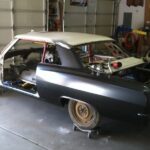Car Parts Toys, often overlooked in the vast toy market, offer a unique blend of entertainment and education. More than just miniature vehicles, these toys delve into the fascinating world of automotive engineering, allowing children and adults alike to explore the intricate components that make cars run. From engines and wheels to transmissions and brakes, car parts toys provide a hands-on way to learn about mechanics while having fun.
Why Car Parts Toys Are More Than Just Playthings
Unlike generic toy cars, car parts toys often come as kits or sets that require assembly, mirroring the actual process of building or repairing a vehicle. This aspect introduces several key benefits:
- Educational Value: They provide a tangible way to understand how different car parts function and interact. Children can learn about basic mechanical principles, problem-solving, and spatial reasoning as they assemble the toys.
- STEM Learning: Car parts toys are excellent STEM (Science, Technology, Engineering, and Mathematics) tools. They encourage curiosity about engineering and mechanics, potentially sparking interest in related fields.
- Fine Motor Skills Development: Assembling small and detailed car parts improves dexterity and fine motor skills, which are crucial for various tasks, from writing to more complex manual activities.
- Creativity and Imagination: While some car parts toys focus on replicating real car components, others offer opportunities for creative customization. Kids can mix and match parts, building unique vehicles and scenarios, fostering their imagination.
- Adult Hobby and Collectibles: The appeal of car parts toys isn’t limited to children. Adults also find enjoyment in collecting detailed model car engines, transmissions, or chassis, often as display pieces or as part of larger model car projects.
Types of Car Parts Toys Available
The market offers a diverse range of car parts toys, catering to different age groups and interests. Here are some popular types:
- Model Engine Kits: These kits allow you to build miniature, often working, models of car engines. They can range from simple single-cylinder engines to complex V8 or even rotary engines. Many kits feature transparent parts, allowing you to see the internal mechanisms in action.
- Transmission and Gearbox Models: Focusing on the power transfer system, these toys help understand how gears work to change speed and torque. Some models are functional, letting you shift gears and observe the internal movements.
- Chassis and Suspension Kits: These kits concentrate on the vehicle’s frame and suspension system. Building them provides insights into how the car body is supported and how the suspension system absorbs shocks for a smoother ride.
- Car Building Blocks and Construction Sets: Similar to popular building blocks, these sets are designed to create toy cars and sometimes include specialized car parts like wheels, axles, and body panels. They are often more geared towards younger children.
- Diecast Car Parts and Accessories: For diecast car enthusiasts, there are miniature car parts and accessories available to customize or repair their models. These can include wheels, tires, spoilers, and engine components.
Choosing the Right Car Parts Toy
When selecting a car parts toy, consider these factors to ensure it’s a good fit:
- Age Appropriateness: Check the manufacturer’s recommended age range. Some kits contain small parts that are not suitable for very young children due to choking hazards. Complexity also varies, with some kits being more challenging to assemble than others.
- Interest Level: Consider the recipient’s interest in cars and mechanics. If they are genuinely curious about how cars work, a more detailed model engine or transmission kit might be ideal. For younger children, simpler building block sets might be more engaging.
- Material and Quality: Look for toys made from durable and safe materials. High-quality plastic or metal parts will ensure longevity and a better building experience.
- Complexity and Assembly: Think about the desired level of challenge. Beginner kits are easier to assemble and are great for introducing the concepts. More advanced kits offer a more intricate and rewarding building experience for older children and adults.
- Educational Goals: If you are looking for a toy with specific educational benefits, consider what aspects of car mechanics it focuses on. Engine kits are excellent for understanding combustion, while transmission kits highlight gear ratios and power transfer.
Where to Find Car Parts Toys
Car parts toys are available from various sources:
- Online Retailers: Websites like Amazon, eBay, and specialized toy stores offer a wide selection of car parts toys from different brands and manufacturers.
- Hobby Shops: Hobby shops that cater to model building and remote control vehicles often carry a range of car parts toys, especially model engine and chassis kits.
- Toy Stores: Larger toy store chains and independent toy shops may stock car parts toys, particularly building block sets and simpler models.
- Educational Toy Stores: Stores specializing in educational toys are more likely to carry STEM-focused car parts toys and kits designed for learning.
Conclusion: Unleash the Inner Mechanic with Car Parts Toys
Car parts toys are more than just entertainment; they are valuable tools for learning, creativity, and skill development. Whether you are a child fascinated by cars or an adult hobbyist, exploring the world of car parts toys can be a rewarding and enriching experience. So, dive in, start building, and discover the inner workings of automobiles in a fun and engaging way! Consider gifting a car parts toy to a budding engineer or mechanic in your life and spark their passion for automotive technology.
